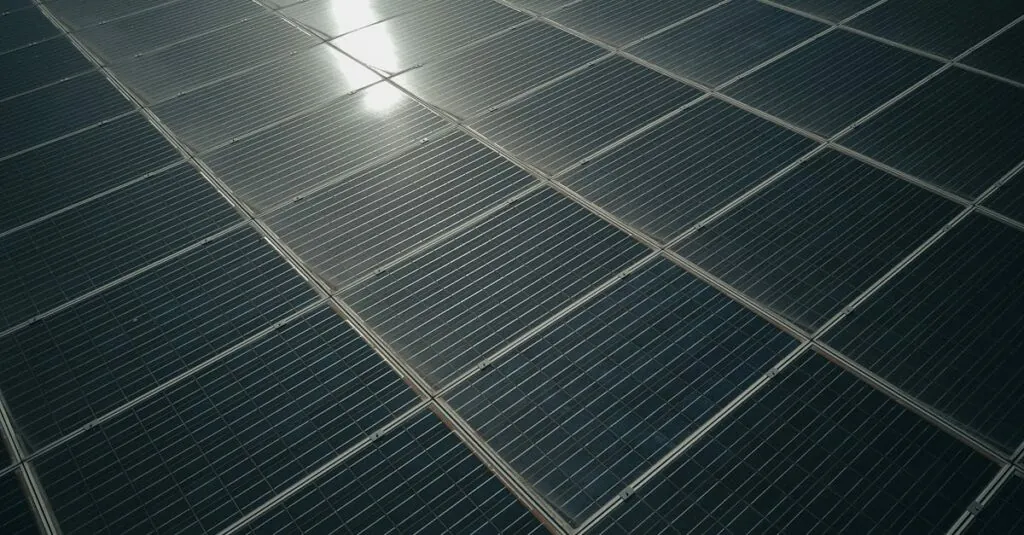Table of Contents
ToggleIn a world where plastic bags seem to multiply like rabbits and carbon footprints rival Bigfoot sightings, sustainable living solutions have never been more crucial. Imagine a life where your morning coffee doesn’t come with a side of guilt and your home is a cozy haven for both you and Mother Earth. It’s not just a dream; it’s a lifestyle choice that’s easier than finding a parking spot at the mall during the holidays.
Understanding Sustainable Living Solutions
Sustainable living solutions play a crucial role in reducing environmental impact. They promote an eco-friendly lifestyle that citizens can adopt seamlessly.
Definition and Importance
Sustainable living encompasses practices that minimize one’s ecological footprint. These approaches foster a balance between fulfilling present needs and protecting resources for future generations. Importance lies in mitigating climate change and preserving biodiversity. A sustainable lifestyle can reduce energy consumption, decrease waste, and promote healthier communities. Increasing awareness around environmental issues amplifies the relevance of sustainable solutions, guiding individuals toward conscientious choices that positively impact the planet.
Key Principles of Sustainability
Key principles of sustainability provide a framework for environmentally friendly practices. Conservation encourages responsible use of resources like water and energy. This principle emphasizes efficient usage to reduce waste. Additionally, the concept of optimization arises, focusing on enhancing systems to minimize environmental harm. The integration of renewable resources offers another pivotal approach, substantiating the shift toward clean energy alternatives. Community engagement fosters collaboration among residents, enhancing local sustainability efforts. These principles create pathways toward a more sustainable future, empowering individuals to make effective changes in their daily lives.
Types of Sustainable Living Solutions
Sustainable living solutions encompass various practices that help reduce environmental impact. These solutions promote eco-friendly lifestyles while addressing global challenges.
Renewable Energy Options
Solar energy serves as a popular choice for many homeowners. Wind power also gains traction, providing clean energy alternatives. Geothermal systems harness the Earth’s heat, offering sustainable heating and cooling options. Some households invest in biomass systems, utilizing organic materials for energy generation. These renewable energy sources contribute to energy independence, lower electricity bills, and reduced fossil fuel reliance.
Waste Reduction Strategies
Composting transforms organic waste into nutrient-rich soil, minimizing landfill impact. Reducing single-use plastics becomes essential for lowering overall waste production. Reusable containers and bags encourage consumers to adopt sustainable habits. Many opt for second-hand goods, extending the life cycle of products and reducing the demand for new items. Thrift stores and online platforms highlight opportunities for responsible consumption.
Sustainable Transportation Methods
Bicycling promotes healthier lifestyles by offering a zero-emission commuting option. Public transit systems provide efficient alternatives to driving, reducing traffic congestion and pollution. Electric vehicles (EVs) increasingly gain popularity due to their reduced carbon emissions. Carpooling allows individuals to share rides, cutting fuel consumption and costs. Walking presents an ideal solution for short distances, encouraging physical activity while avoiding emissions.
Implementing Sustainable Practices at Home
Implementing sustainable practices at home significantly reduces ecological footprints and promotes an eco-friendly lifestyle.
Energy Efficiency Improvements
Energy efficiency encompasses strategies to lower energy consumption. Switching to LED bulbs lessens energy use by up to 75%. Installing programmable thermostats adjusts heating and cooling based on occupancy, optimizing comfort and efficiency. Energy-efficient appliances, like refrigerators and washing machines, consume less power and water, saving households considerable amounts over time. Sealing windows and doors prevents drafts, improving heating and cooling efficiency. Incorporating solar panels harnesses renewable energy, decreasing reliance on fossil fuels and lowering electricity bills.
Water Conservation Techniques
Water conservation involves various approaches to reduce water consumption. Fixing leaks promptly can save homeowners hundreds of gallons annually. Installing low-flow showerheads and faucets diminishes water usage without sacrificing performance. Collecting rainwater for irrigation minimizes dependency on municipal water supplies, promoting sustainable gardening practices. Utilizing drought-resistant landscaping requires significantly less water while enhancing an outdoor space’s beauty. Finally, mindful behaviors such as shorter showers and full loads in dishwashers and washing machines contribute to overall water savings.
Eco-Friendly Materials and Products
Eco-friendly materials and products play a vital role in sustainable living. Choosing bamboo or recycled materials for furniture supports responsible resource use. Utilizing organic cleaning products ensures that harmful chemicals do not enter the environment. Opting for sustainable clothing made from natural fibers reduces reliance on toxic dyes and synthetic materials. When renovating or decorating, using non-toxic paints and finishes promotes indoor air quality. Supporting local businesses that provide environmentally friendly goods strengthens community engagement while minimizing carbon footprints associated with transportation.
Community Involvement in Sustainability
Community involvement plays a crucial role in advancing sustainability efforts. Local groups significantly contribute to creating eco-friendly practices that benefit the environment and residents alike.
Local Initiatives and Programs
Local initiatives and programs often encourage community members to engage in sustainable practices. Neighborhood clean-up events, tree planting efforts, and community gardens serve as focal points for environmental action. These activities foster collaboration among residents, helping them connect with one another while enhancing their surroundings. Programs that facilitate recycling education empower individuals to reduce waste and promote responsible resource use. Additionally, partnerships with local businesses can lead to innovative sustainability practices within the community, making a tangible difference in environmental impacts.
Role of Education and Awareness
Education and awareness are essential in promoting sustainable living. Workshops and seminars help individuals understand the impacts of their consumption habits. Schools can integrate sustainability into their curricula, helping children develop eco-conscious behaviors from an early age. Informational campaigns through social media platforms can reach a broader audience, making sustainability accessible and engaging. By raising awareness about the importance of sustainable practices, communities can cultivate a culture of responsibility and encourage residents to make informed decisions that benefit the environment.
Embracing sustainable living solutions is not just a trend but a necessity for a healthier planet. By integrating eco-friendly practices into daily routines individuals can significantly reduce their environmental impact. From renewable energy options to waste reduction strategies every small change contributes to a larger movement toward sustainability.
Community involvement and education play vital roles in fostering a culture of responsibility. As more people engage with sustainable practices the collective effort can lead to meaningful change. The journey toward a sustainable lifestyle may seem daunting but it’s filled with opportunities for creativity and collaboration. With determination and awareness everyone can be part of the solution for a greener future.




